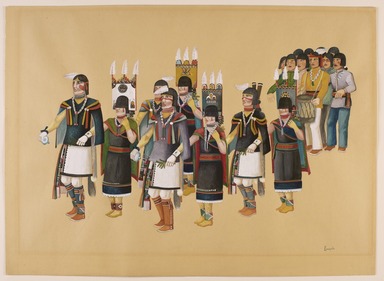
Artist:Louis Lomayesva
Medium: Watercolor on paper
Dates:1930s
Dimensions: 15 15/16 x 21 15/16 in. (40.5 x 55.7 cm)
Collections:
Exhibitions:
Accession Number: 40.90
Image: 40.90_PS20.jpg,
Catalogue Description: Louis Lomayesva (also known as Lewis Lomay) depicts the dancers and drummers of the Hopi Corn Dance. Representing life, corn is the most important symbol for the Hopi. Like many of his contemporary Native American watercolorists, Lomayesva omitted the background in his images, thereby emphasizing the figures while adding a timeless quality. At the same time, his paintings mirror reality, as seen in the fine details of the woven designs on the dancers' shawls and belts. Native American watercolor painting, depicting scenes from everyday life and ceremonial dances, arose in the 1920s, stimulated by growing interest among white patrons. Drawing from a long tradition of painted hides, pottery, and wall murals, artists incorporated Native painting styles with the European-derived medium of watercolor to create a new Native American art form. At the heart of this movement were various self-taught artists from the southwestern United States, particularly from Hopi and Pueblo cultures. In 1930 the Brooklyn Museum was one of the first museums in the country to feature an exhibition of watercolors by Native American painters from the Southwest.